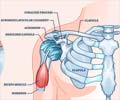Radiologists are using a new minimally invasive procedure to treat tendonitis in the shoulder.
Radiologists are using a new minimally invasive procedure to treat tendonitis in the shoulder. Ultrasound-guided non-surgical therapy significantly reduces pain from calcific tendonitis of the rotator cuff and restores mobility, according to a study presented today at the annual meeting of the Radiological Society of North America (RSNA).
“This is a quick, successful and inexpensive therapy for tendon calcifications,” said Luca M. Sconfienza, M.D., from the Department of Radiology at A.O. Ospedale Santa Corona in Pietra Ligure and the Department of Experimental Medicine at the University of Genova in Italy. “It provides significant and long-lasting reduction of symptoms.”Calcific tendonitis is a condition that causes the formation of small calcium deposits within the tendons of the rotator cuff in the shoulder. It is most common in adults 30 to 40 years old. In most cases, the deposits become painful and can restrict mobility of the shoulder. In minor cases, physical therapy or anti-inflammatory medications may be sufficient to address the problem until the calcifications break apart spontaneously. In severe cases, patients may require shockwave treatment or open surgery to remove the calcium.
Ultrasound-guided percutaneous (through the skin) therapy represents an effective and inexpensive alternative to surgery that is less stressful for the patient. For the 10-minute procedure, the shoulder is anesthetized and, with ultrasound guidance, a radiologist injects a saline solution into the rotator cuff to wash the area and break up the calcium. A second needle is used to aspirate, or withdraw, the calcium residue. Recovery time is about an hour. Calcifications that are completely treated do not ever return.
“Calcifications can break up on their own. Unfortunately, this can take from a few months to several years,” Dr. Sconfienza said. “This means the pain could persist for years before its spontaneous resolution.”
In addition, when untreated calcifications break up, the calcium is not extracted but spreads along the tendon and lodges in the subacromial bursa, a fluid sac that helps lubricate the tendon. Calcium buildup in the tendon and bursa can cause bursitis, a painful condition with a long recovery time and a high grade of disability.
For the study, Dr. Sconfienza and colleagues used ultrasound-guided percutaneous therapy to treat 2,543 shoulders in 1,607 women and 938 men (mean age 42) with calcific tendonitis. All of the patients had shoulder pain that was unresponsive to previous medical treatment. One-year follow-up was reported for 2,018 of the patients in the study.
Advertisement
While Ospedale Santa Corona and the University of Genova are among few institutions currently offering this new therapy, Dr. Sconfienza says that theoretically, the procedure could be performed in any hospital or clinic that has ultrasound equipment with a superficial probe.
Advertisement
Source-Eurekalert
LIN/M











